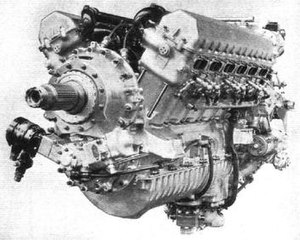Rolls-Royce Peregrine
| Peregrine | |
|---|---|
 |
|
| Type | Piston V-12 aero engine |
| Manufacturer | Rolls-Royce Limited |
| First run | 1938 |
| Major applications | Westland Whirlwind |
| Number built | 301 |
| Developed from | Rolls-Royce Kestrel |
| Developed into | Rolls-Royce Vulture |
The Rolls-Royce Peregrine was a 21-litre (1,300 cu in), 885-horsepower (660 kW) liquid-cooled V-12 aero engine designed and built by the British manufacturer Rolls-Royce in the late 1930s. It was essentially the ultimate development of the company's Kestrel engine, which had seen widespread use in military aircraft of the pre-war period.
Due to the wartime priority of Rolls-Royce Merlin development and production, the Peregrine saw limited use and was cancelled with only 301 engines being built.
During the 1930s the use of superchargers to increase "effective displacement" of an aircraft engine came into common use. Charging of some form was a requirement for high-altitude flight, and as the strength of the engines improved there was no reason not to use it at all times.
The Kestrel used supercharging for boost from the start, but by the 1930s it had reached the limits of what its frame could handle in terms of power output. However, there was room to improve the strength of the engine, which would allow it to run at even higher boost levels with only modest increases in weight. This improved the power-to-weight ratio considerably, and it was generally felt that the resulting design would be the "standard" fighter engine for the impending war.
Following the company convention of naming its piston aero engines after birds of prey, Rolls-Royce named the engine the Peregrine after the peregrine falcon (Falco peregrinus), the world's fastest and most widespread bird of prey.
A design feature of the Peregrine was that it was produced in both right- and left-hand tractor variants. This was done to improve aircraft handling by providing a counter-rotating propeller facility. This was a common feature of German designs, but relatively rare on UK engines. The handing of internal parts to achieve this was a considerable complication that was later abandoned in favour of an idler gear arrangement for the Merlin propeller reduction gear.
Four Kestrel/Peregrine cylinder banks attached to a single crankcase and driving a single common crankshaft would produce the contemporary Rolls-Royce Vulture, a 1,700-horsepower (1,300 kW) X-24 which would be used for bombers.
...
Wikipedia
